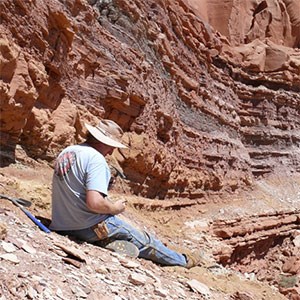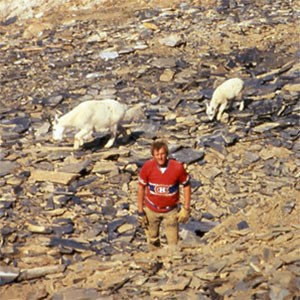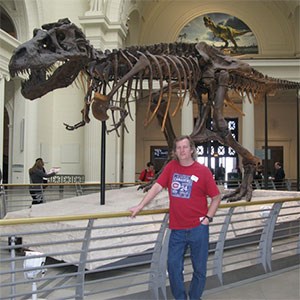Part of a series of articles titled Meet A Paleontologist.
Article
Andrew R. C. Milner, St. George Dinosaur Discovery Site at Johnson Farm, Utah

Site Paleontologist and Curator, St. George Dinosaur Discovery Site at Johnson Farm, Utah
What is your job, and what do you study?
I am the paleontologist and curator at a dinosaur tracks museum in southwestern Utah. I specialize in Late Triassic and Early Jurassic tracks and traces, especially those of dinosaurs. I am also in charge of our museum preparation lab, assist with museum exhibits, provide lectures and tours to school groups and the general public, and conduct and coordinate all kinds of paleontological field work, mostly in southern Utah. Occasionally I do sub-contract work for environmental consulting companies, construction companies, and the Utah Department of Transportation. I help them by conducting paleontological surveys when new roads are being constructed or older roads expanded. I have and continue to work with the Bureau of Land Management, National Park Service, and National Forest Service on various paleontology projects as well.

What are you working on now?
As usual, I have more projects going on at one time than I should have! I am working on a spectacular block of dinosaur tracks (nicknamed the "MegaTrack Block") from the Early Jurassic Navajo Sandstone Formation in Glen Canyon National Recreation area along the shores of Lake Powell, Utah. I continue to work with a group of other scientists on fossils and geology from the Late Triassic Chinle Formation in San Juan County, Utah. I'm also working on research publications on vertebrate tracks, invertebrate trace fossils, vertebrate body fossils, and plants from the Moenkopi, Chinle, Moenave, Kayenta, and Navajo formations of southwestern Utah. Finally, I continue to work periodically on a larger research paper about the fauna and flora of the Late Pleistocene Champlain Sea deposits of eastern Canada - this is where I got my start in vertebrate paleontology back in 1974!

Where did you go to school? What were some of your favorite classes that you took?
I did my undergraduate degree, majoring in Geology and Biology at Brock University in St. Catharines, Ontario, Canada. I had planned on doing a Master's degree in earth sciences, but other things in my life (my family especially) put me on a different track. However, I am constantly studying paleontology and geology, along with gaining lots of valuable experiences in many branches of paleontology both in the lab and field. I still plan on pursuing a Master's degree in the not too distant future. If all goes well, I will follow this up with a doctorate degree in geosciences. As an undergraduate, some of my favorite classes were vertebrate and invertebrate paleontology, vertebrate and invertebrate zoology, sedimentology, and stratigraphy.
Was there an experience you had that made you realize you wanted to be a paleontologist?
A few months after moving to Quebec, Canada from Yorkshire, England in 1971 at the age of six, my aunt came to visit us. We went on a short hike to visit an old dam near our house in the Laurentian Mountains when my aunt picked up a brachiopod shell fossil in the gravel near the dam. I was immediately fascinated and began collecting these fossils and on returning home, my brother gave me a children's book on prehistoric animals. That's when I saw my first dinosaur and immediately became drawn to paleontology. My parents often took me to the Canadian Museum of Nature (CMN) in Ottawa where I eventually met Dr. C. Richard Harington who introduced me to Late Pleistocene fossils of the Champlain Sea in 1974. I was hooked! Ironically, many years later, I ended up donating my Champlain Sea collection to CMN. Soon afterward, CMN hired me on with a part time job working with Champlain Sea fossils.
What is your most memorable experience working with fossils?
This is a very tough question, because I have had so many incredible experiences working with fossils! I have made so many lifelong friends through the field of paleontology as well. Fieldwork is by far the best part of my job. Discovering the remains of past life is such an awesome experience and knowing that you are the first person to ever see it is exhilarating to me. For example, the first time I split open a 10,000 year old Champlain Sea fish fossil in a limestone nodule, I broke into tears of joy!
Do you have any advice for aspiring paleontologists?
Don't do what I did in terms of school! Try your very best at everything they throw at you. I definitely went about it the hard way in earning my title as a paleontologist. Work hard in school on all subjects, and don't give up on your passion. Lots of reading and writing is important, and if you're good at art, then keep that up too. Art (drawing, painting, sculpture, photography) is very important in paleontology especially when it comes to creating scientific illustrations of fossils, restorations of plants, animals, and the environments they lived in. If you can, volunteer at your local museum or university in order to gain experience. Networking is very important too - getting to know other paleontologists, geologists, and biologists at museums, universities, and meetings is very important. Jobs in this field are often hard to come by so making a good impression on your peers is important as well as gaining as much experience in the field and on the subject as you possibly can.
Last updated: May 10, 2019
